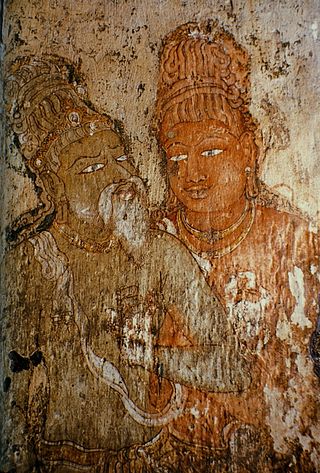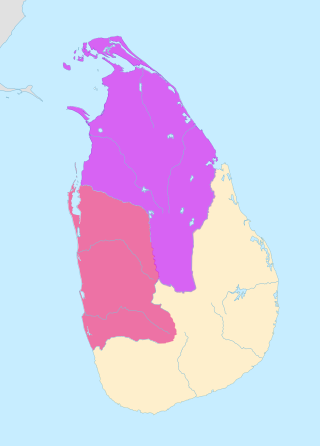
The Sri Lankan Rupee is the currency of Sri Lanka. It is subdivided into 100 cents, but cents are rarely seen in circulation due to their low value. It is issued by the Central Bank of Sri Lanka. The abbreviation Re (singular) and Rs (plural) is generally used, the World Bank suggests SL Rs as a fully disambiguating abbreviation for distinction from other currencies named "rupee".

Rajaraja I, also known as Rajaraja the Great, was a Chola emperor who reigned from 985 CE to 1014 CE. He is known for his conquests of southern India and parts of Sri Lanka, and increasing Chola influence across the Indian Ocean. Rajaraja's birth name was Arulmozhi Varman.

The Chola dynasty was a Tamil dynasty originating from Southern India. At its height, it ruled over the Chola Empire, an expansive maritime empire. The earliest datable references to the Chola are from inscriptions dated to the 3rd century BCE during the reign of Ashoka of the Maurya Empire. The Chola empire was at its peak and achieved imperialism under the Medieval Cholas in the mid-9th century CE. As one of the Three Crowned Kings of Tamilakam, along with the Chera and Pandya, the dynasty continued to govern over varying territories until the 13th century CE.
Kalinga Magha or Gangaraja Kalinga Vijayabahu was an invader from the Kingdom of Kalinga who usurped the throne from Parakrama Pandyan II of Polonnaruwa in 1215. A massive migration followed of Sinhalese people to the south and west of Sri Lanka, and into the mountainous interior, as they attempted to escape his power. Magha was the last ruler to have his seat in the traditional northern seat of native power on the island, known as Rajarata; so comprehensive was his destruction of Sinhalese power in the north that all of the successor kingdoms to Rajarata existed primarily in the south of the island.

The Chola Empire, which is often referred to as the Imperial Cholas, was a medieval thalassocratic empire based in southern India that was ruled by the Chola dynasty, and comprised overseas dominions, protectorates and spheres of influence in southeast Asia.

Kulothunga III was a Chola emperor who ruled from 1178 to 1218 CE, after succeeding his elder brother Rajadhiraja II. Kulothunga Chola III gained success in war against his traditional foes. He gained victories in war against the Hoysalas, Pandyas of Madurai, Cheras of Venad, the Sinhalese kings of Polonnaruwa, as well as the Telugu Cholas of Velanadu and Nellore. He also restored Chola control over Karur, which were ruled by the Adigaman chiefs as vassals of the Cholas. He drove out the Hoysalas under Veera Ballala II who had made inroads in the Gangavadi and adjoining areas of Tagadur in Kongu country in an effort expand their territory. However, during the last two years of his reign, he lost in war to the resurgent Pandyas, heralded a period of steady decline and ultimately, demise of the Cholas by 1280 CE. Kulottunga III had alliances with the Hoysalas. The Hoysala king Veera Ballala married a Chola queen called Cholamahadevi and gave his daughter Somaladevi in marriage to Kulottunga III.

Parākramabāhu I, or Parakramabahu the Great, was the king of Polonnaruwa from 1153 to 1186. He oversaw the expansion and beautification of his capital, constructed extensive irrigation systems, reorganised the country's army, reformed Buddhist practices, encouraged the arts and undertook military campaigns in South India and Burma. The adage, "Not even a drop of water that comes from the rain must flow into the ocean without being made useful to man" is one of his most famous utterances."
Most of the pre-modern coinage used in Sri Lanka or coins used in pre-Christian Sri Lanka can be categorised as punch-marked coins, tree and swastika coins, elephant and swastika coins and Lakshmi plaques.

The Kingdom of Polonnaruwa was the Sinhalese kingdom that expanded across the island of Sri Lanka and several overseas territories, from 1070 until 1232. The kingdom started expanding its overseas authority during the reign of Parakramabahu the Great.
Vijayabahu the Great, also known as Vijayabahu I, was a medieval king of Sri Lanka. Born to a royal bloodline, Vijayabahu grew up under Chola occupation. He assumed rulership of the Ruhuna principality in the southern parts of the country in 1055. Following a seventeen-year-long campaign, he successfully drove the Cholas out of the island in 1070, reuniting the country for the first time in over a 77 years later. During his reign, he re-established Buddhism in Sri Lanka and repaired much of the damage caused to infrastructure during the wars. He offered the Thihoshin Pagoda(Lord of Sri Lanka Buddha image) to Burma king Alaungsithu and it is now still in Pakokku.

Setu coins or Setu bull coins are found in large quantities in the northern part of Sri Lanka and in Southern India. Numismatists have clearly pointed out that the traditional design of Sri Lanka standing King Type Copper Massa (coins) of the Jaffna Kingdoms belongs to the Aryacakravarti dynasty from 1284 AD to 1410 AD. Setu coins were previously attributed to the Setupati Princes of Ramanathapuram in South India. There are two series one in the issued from the 13th to the 15th centuries and the other after the brief loss of sovereignty to the rival Kotte kingdom from 1450 to 1467 and reconstitution of the Kingdom. Even during the rule of Sapumal Kumaraya coins were issued in Jaffna that was distinct. Three types of this series are illustrated below. The obverse of these coins have a human figure flanked by lamps and the reverse has the Nandi (bull) symbol, the legend Sethu in Tamil with a crescent moon above.

The earliest coins of the Pandyan Kingdom were copper squares and were struck with a die. The coins were with five distinct images on one side, often an image of an elephant on that side and a stylised fish on the other, seen typically in the coins found around Korkai, their ancient capital and in Northern Lanka. These rectangular coins of the early Pandyans also featured the Nandi bull and contain Chakrams. The "Chakram" consists of two lines forming an acute angle, the apex being uppermost; with are two crossed lines parallel to the sides of the angle which they join. All four lines end at the bottom of the symbol on the same level. This symbol but with the outer lines somewhat shorter than the inner is used by certain Tamils in the Anuradhapura District as a brand-mark for cattle; a variant with the outer lines continued beyond the apex in the form of a loop or of a pair of pincers occurs in the Northern Province and represents a makara. The symbol or brandmark on the coin being a conventional fish, the well-known Pandyans badge.

Nissanka Malla, also known as Keerti Nissanka and Kalinga Lokesvara was a king of Polonnaruwa who ruled the country from 1187 to 1196. He is known for his architectural constructions such as the Nissanka Lata Mandapaya, Hatadage and Rankot Vihara, as well as for the refurbishment of old temples and irrigation tanks.

The Anuradhapura kingdom, named for its capital city, was the second established kingdom of ancient Sri Lanka. According to the Mahāvaṃsa, it was founded by King Pandukabhaya in 437 BC, whose authority extended throughout the country.
Mahinda V was King of Anuradhapura in the 11th century. He was the last king of the Anuradhapura Kingdom as well as from the House of Lambakanna II. In 993, he fled to Ruhuna, the southern part of the country, following a large scale mutiny by his army. A Chola invasion led by Rajaraja Chola I captured Anuradhapura taking advantage of the 11 year civil war and subsequent turmoil that happened after Anuradhapura fell into anarchy. He was later taken prisoner and taken to India, where he died as a prisoner in 1029. The Mahavamsa records that the rule of Mahinda V was weak and he was unable to even organize the collecting of taxes. The country was in a state of extreme poverty and his army refused to follow orders due to lack of wages.
Lankapura Dandanatha, more commonly referred to as simply Lankapura, was a Senapati of the Sinhala Army during the reign of King Parakramabahu I. He led an expeditionary force to South India in support of the Pandyan king Parakrama Pandyan I, bringing parts of Pandya Nadu under their control. Lankapura succeeded in restoring the Pandyan prince to the throne, and ordered the use of Sri Lankan currency in areas under his and Pandyan prince control. Then he was beheaded by Pallavarayar alias Tirucirrambalamudaiyan perumanambi

The Anuradhapura period was a period in the history of Sri Lanka of the Anuradhapura Kingdom from 377 BCE to 1017 CE. The period begins when Pandukabhaya, King of Upatissa Nuwara moved the administration to Anuradhapura, becoming the kingdom's first monarch. Anuradhapura is heralded as an ancient cosmopolitan citadel with diverse populations.

The Chola conquest of Anuradhapura was a military invasion of the Kingdom of Anuradhapura by the Chola Empire. The period of Chola entrenchment in entire Sri Lanka lasted in total about three-quarters of a century, from roughly 993 CE to 1070 CE, when Vijayabahu I recaptured the north,east and central Sri lanka and expelled the Chola forces restoring Sinhalese sovereignty.
When to date the start of the history of the Jaffna kingdom is debated among historians.
Manthai is a coastal town and an ancient harbor situated in the Mannar district, of the Northern Province of Sri Lanka. Manthai functioned as the main port of the Anuradhapura Kingdom throughout its history.














